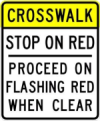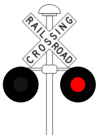|
||
|
|
||
This page last updated April 3, 2024 |
Over the decade or so, a new type of pedestrian crossing signal has been implemented across the US. This signal, officially called a "pedestrian hybrid beacon", is also known as a "HAWK" signal (High-intensity Activated crossWalK beacon) and is used to provide a protected crossing at a location with heavy pedestrian activity that does not warrant a full traffic signal. These are often mid-block locations, but can be located at intersections.
Unlike regular traffic signals, the HAWK signal has no green indication for vehicular traffic. Instead, the vehicular signals are dark until the signal is activated when a pedestrian pushes a button at the crosswalk. At that point, a unique sequence of signal indications is activated. Here is that sequence and the meaning of the corresponding signals:
| VEHICULAR SIGNAL | MEANING | PEDESTRIAN SIGNAL |
 |
Motorists can proceed normally. Pedestrians must wait. |  |
 |
Pedestrian push-button has been activated and the vehicular signal will turn red soon. Pedestrians must wait. Motorists may proceed but should be prepared to stop in case the pedestrian begins crossing prematurely. |  |
 |
The signal is about to change to red. Motorists should slow and stop if able to do so safely. Pedestrians must continue to wait. |  |
 |
All vehicles must stop and remain stopped. Pedestrians may now cross, but should still look both ways to make sure traffic has stopped. |  |
 |
Drivers must stop, then may proceed if the crosswalk on their side is clear of pedestrians. Pedestrians may not start crossing, but may finish crossing if they're already in the crosswalk. |  |
 |
Motorists can proceed normally. Pedestrians must wait. |  |
|
ADVERTISEMENT |
 As a result of this incongruent meaning, many motorists remain stopped when the red lights are flashing even if the way is clear. Although this does not represent a safety issue per se, it creates unnecessary traffic delays, which the flashing red phase is intended to reduce and was ostensibly one of the main reasons for development of this signal. It can also cause aggravation for knowledgeable drivers behind the stopped driver, some of who may honk or otherwise express disapproval. And when knowledgeable drivers do proceed, drivers who are unaware that this is permitted may become frustrated or dismayed at what they believe to be blatant law breaking. To help ameliorate these potential issues, signs such as the one to the right are usually posted, but many drivers simply do not read the signs.
As a result of this incongruent meaning, many motorists remain stopped when the red lights are flashing even if the way is clear. Although this does not represent a safety issue per se, it creates unnecessary traffic delays, which the flashing red phase is intended to reduce and was ostensibly one of the main reasons for development of this signal. It can also cause aggravation for knowledgeable drivers behind the stopped driver, some of who may honk or otherwise express disapproval. And when knowledgeable drivers do proceed, drivers who are unaware that this is permitted may become frustrated or dismayed at what they believe to be blatant law breaking. To help ameliorate these potential issues, signs such as the one to the right are usually posted, but many drivers simply do not read the signs.
Less serious is the conflict presented by the dark vehicular indication when no pedestrians are crossing. Motorists are instructed to treat dark signals as a stop sign, so having a dark signal that can be ignored injects more inconsistency into the traffic system. That said, there is a precedent for this with ramp metering signals that are dark when not used, and Texas law exempts drivers from stopping at both dark meter signals and HAWK signals.
Commentary
In the opinion of this author, while studies have shown HAWK signals to be effective in and of themselves, the need for a completely different signal display for crosswalks is questionable. The existing red-yellow-green signal can be (and has been in some states) easily adapted to provide the same operation and benefits as a HAWK signal using signals that drivers are already familiar with.
That aside, the HAWK signal implementation was not fully baked. Particularly, the meaning of the alternating flashing red lights ("wigwag") at a HAWK signal is troublesome as it goes against its longstanding use with other traffic control devices such as railroad crossing signals. Having a meaning different than what is used in other applications is counterproductive for having a system of intuitive and uniform traffic control devices. Consequently, its use with HAWK signals is inappropriate and flawed for both practical and conformity reasons. The Manual on Uniform Traffic Control Devices even requires that horizontally-aligned flashing red lights at an intersection be flashed simultaneously "to avoid being confused with grade crossing flashing-light signals" — if that justification is valid for intersection beacons, why not for HAWK signals?
Yes, signs such as the one shown above are often installed to help educate drivers on the contrary meaning of the flashing red signals in this application. However, having to post a sign to explain a signal meaning that is fundamentally different than the heretofore accepted meaning just reaffirms the HAWK flashing red display is inherently ambiguous. By adopting this display, both the National Committee on Uniform Traffic Control Devices, which evaluates and recommends standards for traffic control devices in the US, and the Federal Highway Administration, which ultimately owns those decisions, have failed in their duty to maintain standardization in the nation's traffic control devices.
Another outcome, and perhaps even more dangerous, is the reverse — that drivers get used to the HAWK wigwag's meaning and then begin to treat ungated railroad crossings and school buses with the same relaxed interpretation.
 The solution is simple: instead of the alternating flashing red lights, the stop-and-proceed-if-safe phase should be indicated by simultaneous red flashing lights as shown to the left. This would be consistent with other signal indications and more intuitive for drivers.
The solution is simple: instead of the alternating flashing red lights, the stop-and-proceed-if-safe phase should be indicated by simultaneous red flashing lights as shown to the left. This would be consistent with other signal indications and more intuitive for drivers.
Even better would be to eliminate the HAWK signal entirely and use a standard red-yellow-green signal with a flashing red signal during the pedestrian clearance interval. Drivers are already familiar with the meaning of this signal, and it would achieve the desired outcome of reducing unnecessary delays. A double-headed red assembly could even be used to increase the visibility.
With regards to the dark signal conflict, a 2016 Federal Highway Administration study did not find that drivers stopped for dark HAWK signals. That said, adding more inconsistency does not advance the idea of a standardized system of traffic laws and devices. Having the HAWK signal display the flashing yellow at times when not in use by a pedestrian would provide a more consistent approach, and it would also have the benefit of warning drivers of a location where pedestrians might be crossing without activating the signal. Or, again, just using a regular red-yellow-green signal that displays a green signal when the crosswalk is not active would be even better.
 |
 |
 |
Other sites of interest
|
|
Wikipedia - HAWK Beacon https://en.wikipedia.org/wiki/HAWK_beacon |


